October 6, 2025
5 mins read
mins read
Ancillary services present a game-changing business opportunity for flexible loads. The inherent flexibility of these loads is their superpower, making them valuable contributors to grid operations. Ancillary services encompass a variety of programs designed to meet the grid operator’s requirements for managing supply and demand, as well as regulating frequency and voltage. The subset of ancillary services related to demand-side management is commonly referred to as demand response.
To understand the concept better, we should first define different types of load from an ERCOT standpoint.
Loads in ERCOT are classified into two categories, 1. Controllable load resources 2. Non-controllable load resources.
This is how ERCOT defines CLRs: Load Resource capable of controllably reducing or increasing consumption under dispatch control by ERCOT
These types of loads can participate in the real-time market and shape the LMP prices through the role they play in SCED. These loads could also participate in other ancillary service programs that will be explained in detail in the next section.
Here is how ERCOT defines that : A Load capable of providing Ancillary Service to the ERCOT System and/or energy in the form of demand response.
ERCOT has four main ancillary service programs, one emergency response service, and some programs still in development or being piloted at limited capacity. In this playbook, we will cover the main ones.
Ancillary services are a variety of programs offered by ERCOT for balancing the grid or in other words frequency regulation and voltage control. Ancillary services are sourced in the Day-Ahead Market (DAM) where participants ( generators and loads) bid in their offers for different times of the day and ERCOT selects the winners based on requirements set by ancillary service plan and grid requirements.
The bids are normally sent in at 10 am and results are announced by 2 PM the same day. By result we mean the winning bids who offered prices equal to or lower than the clearing price. Once a load or generator wins, they’re going to get paid based on the clearing price no matter what their initial offer in the bidding process was. Note that the ancillary services market is cleared simultaneously with the energy market such that the lowest total cost to serve both markets is achieved. It also takes into account the start-up and minimum run costs of the generation. Consequently, there may be bids lower than the clearing price that is either accepted as energy or deemed too expensive when factoring in startup and minimum run costs.
Now let’s dive into different ancillary service programs offered in ERCOT.
Regulation service is a service provided by generators by adjusting the generation up or down in order to manage the frequency of the grid. The response time required for this program is 4 seconds.
Responsive Reserves are resources ERCOT maintains to restore the frequency of the ERCOT System within the first few minutes (usually 10) of an event that causes a significant deviation from the standard frequency, especially when a thermal generator goes offline.
This program is usually fulfilled by generators by offering their excess capacity in the day ahead ancillary services market and by loads meeting the requirement using high-set under-frequency relays.
Non-Spinning Reserve Service (NSRS) consists of generators capable of being ramped to a specified output level within thirty (30) minutes or Loads acting as a Resource that is capable of being interrupted within thirty (30) minutes and that is capable of running (or being interrupted) at a specified output level.
ECRS is a new program that came into effect in the summer of 2023. It is a program available to loads and generators and requires them to respond in a 10-minute interval when there is an error in forecasting or resource trips out.
The chart below from ERCOT monthly operational overview shows the amount allocated to loads for different ancillary service programs. As it can be seen ECRS program which was started in June 2023, has been the main driver and biggest opportunity for loads to participate in ancillary service programs. Since its inception, the ECRS program has paid over $600M to loads who participated in the program. The 2nd best-performing program is RRS and the 3rd is Non-spin. As said earlier, the RRS program is not open to all loads to participate.

In terms of clearing prices, given the fact that ancillary services are priced in the day ahead market, the value could be very different from day to day. But in general, the value could be as high as $1500 per MWh for ECRS and RRS programs and Non-Spin prices are slightly less.
Flexible loads, can bid in for all hours of the day based on the risk of high prices in that hour or based on their breakeven prices.
Although similar to other ancillary services, ERS falls under a whole different category. ERS or emergency response service is a tool deployed by ERCOT whenever the grid requires extra resources. There are three programs under ERS, Weather Sensitive (WS), ERS with 20 minimum response time ( ERS-10), and ERS with 30-minute response time (ERS-30).
Unlike ancillary services, ERS is sourced through 4 annual intakes. The participants bid in their offers and the market chooses the winners based on requirements. Eventually, the winners are paid based on the cleared prices for times of the day and days of the week. In 2023, ERCOT paid an estimated total of $49,000,000 to loads participating in different ERS programs with ERS-30 leading the way compared to the other two.
The value of ERS services varied significantly between $0.29 / MWh to $53/MWh in summer months at high-stress hours. When participating in the ERS programs, flexible loads should note the Uptime requirements and only bid in for hours they are comfortable committing to meet uptime requirements. The hour-of-the-day analysis present in this chapter could be significantly useful for this purpose.
It should also be noted that ERS services have relatively lower value compared to ECRS and non-Spin programs.
The figure below shows a summary of ancillary service and demand response programs and their availability to different types of load.




What to Do Next?
Book an Energy Strategy Call
.svg)